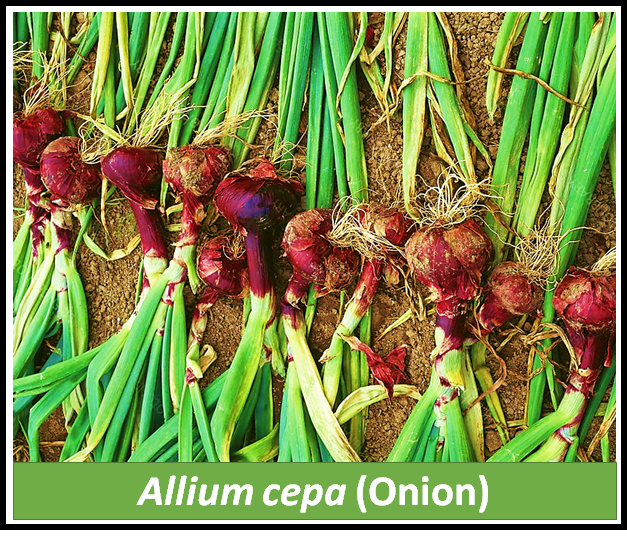
Allium cepa belongs to the family:
(a)Solanaceae
(b)Liliaceae
(c)Cruciferae
(d)Compositae
Answer
488.1k+ views
Hint: Allium cepa belongs to a monocot family. This family has a perianth. The flowers of this family are actinomorphic bisexual, 6 perianth leaves arranged in two whorls of 3 each, stamens are 6 and they arranged in two whorls of 3 each and they are polyandrous, the gynoecium is tricarpellary.
Complete answer:
-The characteristic feature of the Liliaceae family is trimerous flowers with every whorl arranged into
-The gynecium is syncarpous, superior ovary, trilobed stigma, axile placentation.
-Most are perennial herbs {e.g. Colchicum, Allium); some are shrubs (e.g., Asparagus) and climbers (Gloriosa) in this family.
-Roots are adventitious, fibrous, tuberous (Asparagus).
-Leaves of this family usually are radial or cauline, alternate opposite or whorled, estipulate, sessile, sheathing leaf base, with venation parallel.
-Inflorescence is raceme, panicle, cymose umbel (Allium), spike (Aloe).
-Cymes are arranged in an umbellate fashion and enclosed by 2-3 membranous bract.
-Fruits could be a loculicidal (aloe) or septicidal (Gloriosa) capsule or berry (Asparagus).
Additional Information: -Flowers of Allium cepa are small, white, regular bisexual, hypogynous, sometimes replaced by bulbils.
-Gynoecium of Allium cepa is tricarpellary, syncarpous; ovary three-lobed and three celled.
-Placentation in the ovule of Allium cepa is axile.
-The style is short, filiform; stigma minute; ovules are usually two in each cell.
-Fruit of Allium cepa is a membranous capsule.
-Seeds are endospermic.
So, the correct answer is ‘Liliaceae’.
Note: -The Liliaceae family includes the species Fritillaria assyriaca with the largest genome size within angiosperms.
-Solanaceae, Cruciferae, and Compositae belong to the dicotyledon families.
-Brassicaceae family is also known as Cruciferae.

Complete answer:
-The characteristic feature of the Liliaceae family is trimerous flowers with every whorl arranged into
-The gynecium is syncarpous, superior ovary, trilobed stigma, axile placentation.
-Most are perennial herbs {e.g. Colchicum, Allium); some are shrubs (e.g., Asparagus) and climbers (Gloriosa) in this family.
-Roots are adventitious, fibrous, tuberous (Asparagus).
-Leaves of this family usually are radial or cauline, alternate opposite or whorled, estipulate, sessile, sheathing leaf base, with venation parallel.
-Inflorescence is raceme, panicle, cymose umbel (Allium), spike (Aloe).
-Cymes are arranged in an umbellate fashion and enclosed by 2-3 membranous bract.
-Fruits could be a loculicidal (aloe) or septicidal (Gloriosa) capsule or berry (Asparagus).
Additional Information: -Flowers of Allium cepa are small, white, regular bisexual, hypogynous, sometimes replaced by bulbils.
-Gynoecium of Allium cepa is tricarpellary, syncarpous; ovary three-lobed and three celled.
-Placentation in the ovule of Allium cepa is axile.
-The style is short, filiform; stigma minute; ovules are usually two in each cell.
-Fruit of Allium cepa is a membranous capsule.
-Seeds are endospermic.
So, the correct answer is ‘Liliaceae’.
Note: -The Liliaceae family includes the species Fritillaria assyriaca with the largest genome size within angiosperms.
-Solanaceae, Cruciferae, and Compositae belong to the dicotyledon families.
-Brassicaceae family is also known as Cruciferae.

Recently Updated Pages
Master Class 11 Economics: Engaging Questions & Answers for Success

Master Class 11 Business Studies: Engaging Questions & Answers for Success

Master Class 11 Accountancy: Engaging Questions & Answers for Success

Master Class 11 English: Engaging Questions & Answers for Success

Master Class 11 Computer Science: Engaging Questions & Answers for Success

Master Class 11 Maths: Engaging Questions & Answers for Success

Trending doubts
State and prove Bernoullis theorem class 11 physics CBSE

1 ton equals to A 100 kg B 1000 kg C 10 kg D 10000 class 11 physics CBSE

State the laws of reflection of light

One Metric ton is equal to kg A 10000 B 1000 C 100 class 11 physics CBSE

1 Quintal is equal to a 110 kg b 10 kg c 100kg d 1000 class 11 physics CBSE

Difference Between Prokaryotic Cells and Eukaryotic Cells




